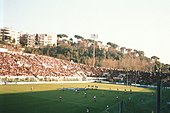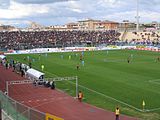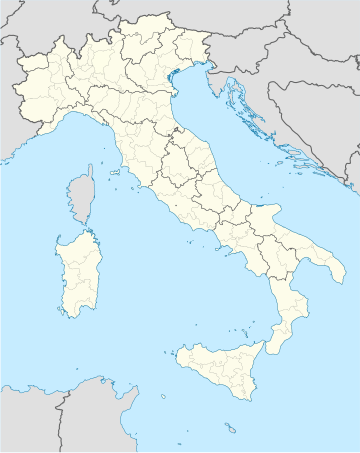| Tournament details | |
|---|---|
| Host country | Italy |
| Dates | 26 August – 10 September |
| Teams | 16 |
| Venue(s) | 7 (in 7 host cities) |
| Final positions | |
| Champions | |
| Runners-up | |
| Third place | |
| Fourth place | |
| Tournament statistics | |
| Matches played | 28 |
| Goals scored | 120 (4.29 per match) |
| Top scorer(s) | |
The football tournament at the 1960 Summer Olympics was held from 26 August to 10 September in 1960 throughout Italy. The tournament featured 16 men's national teams from four continental confederations. The 16 teams were drawn into four groups of four and each group played a round-robin tournament. At the end of the group stage, the first-ranked teams of each group advanced to the semi-finals, and culminating with the gold medal match in Rome on 10 September 1960.[1]
Competition schedule
[edit]The match schedule of the tournament.[2]
| G | Group stage | ¼ | Quarterfinals | ½ | Semifinals | B | Bronze medal match | F | Gold medal match |
| 26 Fri | 27 Sat | 28 Sun | 29 Mon | 30 Tue | 31 Wed | 1 Thu | 2 Fri | 3 Sat | 4 Sun | 5 Mon | 6 Tue | 7 Wed | 8 Thu | 9 Fri | 10 Sat |
|---|---|---|---|---|---|---|---|---|---|---|---|---|---|---|---|
| G | G | G | ½ | ½ | B | F |
Venues
[edit]| Rome | Florence | |
|---|---|---|
| Stadio Flaminio | Stadio Comunale | |
| Capacity: 32,000 | Capacity: 47,920 | |

|

| |
| Grosseto | Livorno | |
| Stadio Olimpico Comunale | Stadio Ardenza | |
| Capacity: 10,200 | Capacity: 19,238 | |

|

| |
| Pescara | Naples | L'Aquila |
| Stadio Adriatico | Stadio Fuorigrotta | Stadio Comunale |
| Capacity: 24,400 | Capacity: 60,240 | Capacity: 9,285 |

|

|

|
Medalists
[edit]Teams
[edit]Qualification
[edit]|
Africa (2) Asia (2) Americas (3) |
Middle East (1) Europe (8)
|
Squads
[edit]First round
[edit]Group 1
[edit]
| Pos | Team | Pld | W | D | L | GF | GA | GD | Pts | Qualification |
|---|---|---|---|---|---|---|---|---|---|---|
| 1 | 3 | 2 | 1 | 0 | 13 | 4 | +9 | 5 | Advanced to knockout stage | |
| 2 | 3 | 2 | 1 | 0 | 8 | 3 | +5 | 5 | ||
| 3 | 3 | 0 | 1 | 2 | 4 | 11 | −7 | 1 | ||
| 4 | 3 | 0 | 1 | 2 | 3 | 10 | −7 | 1 |
| Yugoslavia | 6–1 | |
|---|---|---|
| Report |
|
| Bulgaria | 2–0 | |
|---|---|---|
|
Report |
| Yugoslavia | 4–0 | |
|---|---|---|
| Report |
| Yugoslavia | 3–3 | |
|---|---|---|
|
Report |
| United Arab Republic | 3–3 | |
|---|---|---|
| Report |
|
Group 2
[edit]
| Pos | Team | Pld | W | D | L | GF | GA | GD | Pts | Qualification |
|---|---|---|---|---|---|---|---|---|---|---|
| 1 | 3 | 2 | 1 | 0 | 9 | 4 | +5 | 5 | Advanced to knockout stage | |
| 2 | 3 | 2 | 0 | 1 | 10 | 6 | +4 | 4 | ||
| 3 | 3 | 1 | 1 | 1 | 8 | 8 | 0 | 3 | ||
| 4 | 3 | 0 | 0 | 3 | 3 | 12 | −9 | 0 |
| Brazil | 4–3 | |
|---|---|---|
| Report |
| Brazil | 5–0 | |
|---|---|---|
|
Report |
| Italy | 2–2 | |
|---|---|---|
|
Report |
| Great Britain | 3–2 | |
|---|---|---|
| Report |
|
Group 3
[edit]
| Pos | Team | Pld | W | D | L | GF | GA | GD | Pts | Qualification |
|---|---|---|---|---|---|---|---|---|---|---|
| 1 | 3 | 3 | 0 | 0 | 8 | 4 | +4 | 6 | Advanced to knockout stage | |
| 2 | 3 | 2 | 0 | 1 | 6 | 4 | +2 | 4 | ||
| 3 | 3 | 1 | 0 | 2 | 7 | 5 | +2 | 2 | ||
| 4 | 3 | 0 | 0 | 3 | 3 | 11 | −8 | 0 |
| Denmark | 3–2 | |
|---|---|---|
|
Report |
| Denmark | 3–1 | |
|---|---|---|
|
Report |
|
| Argentina | 2–0 | |
|---|---|---|
| Report |
Group 4
[edit]
| Pos | Team | Pld | W | D | L | GF | GA | GD | Pts | Qualification |
|---|---|---|---|---|---|---|---|---|---|---|
| 1 | 3 | 3 | 0 | 0 | 15 | 3 | +12 | 6 | Advanced to knockout stage | |
| 2 | 3 | 1 | 1 | 1 | 3 | 9 | −6 | 3 | ||
| 3 | 3 | 1 | 0 | 2 | 6 | 9 | −3 | 2 | ||
| 4 | 3 | 0 | 1 | 2 | 3 | 6 | −3 | 1 |
| Hungary | 7–0 | |
|---|---|---|
| Report |
Knockout stage
[edit]Bracket
[edit]| Semi-finals | Gold medal match | |||||
| 5 September – Naples | ||||||
| 1 | ||||||
| 10 September – Rome | ||||||
| 1 | ||||||
| 3 | ||||||
| 5 September – Rome | ||||||
| 1 | ||||||
| 2 | ||||||
| 0 | ||||||
| Bronze medal match | ||||||
| 9 September – Rome | ||||||
| 2 | ||||||
| 1 | ||||||
Semi-finals
[edit]Yugoslavia declared winners by lot.
| Denmark | 2–0 | |
|---|---|---|
|
Report |
Bronze medal match
[edit]| Hungary | 2–1 | |
|---|---|---|
| Report |
|
Gold medal match
[edit]| Yugoslavia | 3–1 | |
|---|---|---|
| Report |
|
|
Yugoslavia
|
Denmark
|
|
| ||||||||||||||||||||||||||||||||||||||||||||||||||||||||||||||||||||||||||||||||||||
Goalscorers
[edit]With seven goals, Milan Galić of Yugoslavia is the top scorer in the tournament. In total, 120 goals were scored by 56 different players, with only one of them credited as own goal.
- 7 goals
 Milan Galić (Yugoslavia)
Milan Galić (Yugoslavia)
- 6 goals
 Bora Kostić (Yugoslavia)
Bora Kostić (Yugoslavia)
- 5 goals
 Harald Nielsen (Denmark)
Harald Nielsen (Denmark) Flórián Albert (Hungary)
Flórián Albert (Hungary) János Dunai (Hungary)
János Dunai (Hungary) János Göröcs (Hungary)
János Göröcs (Hungary) Ernest Pohl (Poland)
Ernest Pohl (Poland)
- 4 goals
 Juan Carlos Oleniak (Argentina)
Juan Carlos Oleniak (Argentina) Gérson (Brazil)
Gérson (Brazil) Bobby Brown (Great Britain)
Bobby Brown (Great Britain) Giorgio Rossano (Italy)
Giorgio Rossano (Italy)
- 3 goals
 Todor Diev (Bulgaria)
Todor Diev (Bulgaria) Gianni Rivera (Italy)
Gianni Rivera (Italy)
- 2 goals
 China (Brazil)
China (Brazil) Roberto Dias (Brazil)
Roberto Dias (Brazil) Spiro Debarski (Bulgaria)
Spiro Debarski (Bulgaria) Flemming Nielsen (Denmark)
Flemming Nielsen (Denmark) Paddy Hasty (Great Britain)
Paddy Hasty (Great Britain) Jim Lewis (Great Britain)
Jim Lewis (Great Britain) Tulsidas Balaram (India)
Tulsidas Balaram (India) Ugo Tomeazzi (Italy)
Ugo Tomeazzi (Italy) Nicolas Nieri (Peru)
Nicolas Nieri (Peru) Alberto Ramírez (Peru)
Alberto Ramírez (Peru) Chuk Yin Yiu (Republic of China)
Chuk Yin Yiu (Republic of China) Brahim Kerrit (Tunisia)
Brahim Kerrit (Tunisia) Raafat Attia (United Arab Republic)
Raafat Attia (United Arab Republic) Samir Qotb (United Arab Republic)
Samir Qotb (United Arab Republic) Tomislav Knez (Yugoslavia)
Tomislav Knez (Yugoslavia)
- 1 goal
 Carlos Bilardo (Argentina)
Carlos Bilardo (Argentina) Raúl Adolfo Pérez (Argentina)
Raúl Adolfo Pérez (Argentina) Waldir (Brazil)
Waldir (Brazil) Wanderley (Brazil)
Wanderley (Brazil) Hristo Hristov (Bulgaria)
Hristo Hristov (Bulgaria) Georgi Naidenov Yordanov (Bulgaria)
Georgi Naidenov Yordanov (Bulgaria) Henning Enoksen (Denmark)
Henning Enoksen (Denmark) Poul Pedersen (Denmark)
Poul Pedersen (Denmark) Jørn Sørensen (Denmark)
Jørn Sørensen (Denmark) Gérard Coinçon (France)
Gérard Coinçon (France) André Giamarchi (France)
André Giamarchi (France) Yvon Quédec (France)
Yvon Quédec (France) Pál Orosz (Hungary)
Pál Orosz (Hungary) Gyula Rákosi (Hungary)
Gyula Rákosi (Hungary) Pradip Kumar Banerjee (India)
Pradip Kumar Banerjee (India) Giovanni Fanello (Italy)
Giovanni Fanello (Italy) Paride Tumburus (Italy)
Paride Tumburus (Italy) Tomás Iwasaki (Peru)
Tomás Iwasaki (Peru) Ángel Uribe (Peru)
Ángel Uribe (Peru) Zygmunt Gadecki (Poland)
Zygmunt Gadecki (Poland) Stanisław Hachorek (Poland)
Stanisław Hachorek (Poland) Mok Chun-wah (Republic of China)
Mok Chun-wah (Republic of China) Moncef Chérif (Tunisia)
Moncef Chérif (Tunisia) Uğur Köken (Turkey)
Uğur Köken (Turkey) Bilge Tahran (Turkey)
Bilge Tahran (Turkey) İbrahim Yalçınkaya (Turkey)
İbrahim Yalçınkaya (Turkey) Željko Matuš (Yugoslavia)
Željko Matuš (Yugoslavia)
- Own goals
 El Sayed Rifai (United Arab Republic; playing against Yugoslavia)
El Sayed Rifai (United Arab Republic; playing against Yugoslavia)
Final ranking
[edit]| Pos | Team | Pld | W | D | L | GF | GA | GD | Pts |
|---|---|---|---|---|---|---|---|---|---|
| 1 | 5 | 3 | 2 | 0 | 17 | 6 | +11 | 8 | |
| 2 | 5 | 4 | 0 | 1 | 11 | 7 | +4 | 8 | |
| 3 | 5 | 4 | 0 | 1 | 17 | 6 | +11 | 8 | |
| 4 | 5 | 2 | 2 | 1 | 11 | 7 | +4 | 6 | |
| 5 | 3 | 2 | 1 | 0 | 8 | 3 | +5 | 5 | |
| 6 | 3 | 2 | 0 | 1 | 10 | 6 | +4 | 4 | |
| 7 | 3 | 2 | 0 | 1 | 6 | 4 | +2 | 4 | |
| 8 | 3 | 1 | 1 | 1 | 8 | 8 | 0 | 3 | |
| 9 | 3 | 1 | 1 | 1 | 3 | 9 | −6 | 3 | |
| 10 | 3 | 1 | 0 | 2 | 7 | 5 | +2 | 2 | |
| 11 | 3 | 1 | 0 | 2 | 6 | 9 | −3 | 2 | |
| 12 | 3 | 0 | 1 | 2 | 4 | 11 | −7 | 1 | |
| 13 | 3 | 0 | 1 | 2 | 3 | 6 | −3 | 1 | |
| 14 | 3 | 0 | 1 | 2 | 3 | 10 | −7 | 1 | |
| 15 | 3 | 0 | 0 | 3 | 3 | 11 | −8 | 0 | |
| 16 | 3 | 0 | 0 | 3 | 3 | 12 | −9 | 0 |
References
[edit]- ^ "Football at the 1960 Rome Summer Games". Sports Reference. Archived from the original on 17 April 2020. Retrieved 14 October 2018.
- ^ "Match Schedule for Olympic Football Tournament Rome 1960". FIFA.com. Fédération Internationale de Football Association. Retrieved 12 July 2021.
External links
[edit]- Olympic Football Tournament Rome 1960 at FIFA.com
- Summary at RSSSF
- Danish tournament squads Archived 26 September 2015 at the Wayback Machine (in Danish)
- Hungarian medalists – Rome 1960 (archived)


Well, that’s interesting to know that Psilotum nudum are known as whisk ferns. Psilotum nudum is the commoner species of the two. While the P. flaccidum is a rare species and is found in the tropical islands. Both the species are usually epiphytic in habit and grow upon tree ferns. These species may also be terrestrial and grow in humus or in the crevices of the rocks.
View the detailed Guide of Psilotum nudum: Detailed Study Of Psilotum Nudum (Whisk Fern), Classification, Anatomy, Reproduction